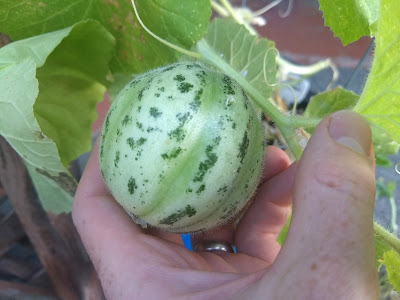After
growing carosello cucumber-melons for a number of years, one of the
main concerns that I have as a grower is consistency. When I say
consistency , I mean that the cucumber variety that I grow comes “true
to type”. This means that I expect the cucumbers to be a specific size,
shape and color. Dark cucumbers should remain dark, light cucumbers
should be light, striped cucumbers should exhibit bands of light and
dark, etc.
Both consistency and honest packaging are a real concern when I purchase seed from Italy. I often find that the packaging may be correct but the fruit is not consistent or the fruit looks much different from the packaging but is at least consistent. Very rarely do I find that the fruit matches both the name, the packet photo and consistently produces what it is supposed to.
One variety that is often mixed up is the Carosello Tondo Manduria or – what I refer to as the Mandurian Round. This variety can come either as light and larger or speckled and possibly a little smaller. The two varieties can often get mixed up in the seed packets. Additionally, my Italian friend Giuseppe has informed me that there is another variety that is very similar to the light one.
In any case, when growing out this variety, I like to know that the seed I am growing produces fruit that is true-to-type. Like most gardeners I know, I like to trust that what I am growing is what I’ll get. This Mandurian Round is one of the few varieties that developed just I had hoped. I was so grateful for this. I’m thinking of possibly reserving one of my plots this upcoming year for a growout of the Mandurian Round. Each time that I save pure seed, I increase the genetic stability of each of my home-grown varieties. One huge reward of being a wise steward with each cucumber variety I am entrusted with is that it me enables me to better appreciate all the work involved in the initial breeding each of these beautiful and delicious carosello cultivars.
 |
| Perfect color and texture for the Mandurian Round. |
Both consistency and honest packaging are a real concern when I purchase seed from Italy. I often find that the packaging may be correct but the fruit is not consistent or the fruit looks much different from the packaging but is at least consistent. Very rarely do I find that the fruit matches both the name, the packet photo and consistently produces what it is supposed to.
 |
| The greenhouse plants were moved outside during a vacation |
One variety that is often mixed up is the Carosello Tondo Manduria or – what I refer to as the Mandurian Round. This variety can come either as light and larger or speckled and possibly a little smaller. The two varieties can often get mixed up in the seed packets. Additionally, my Italian friend Giuseppe has informed me that there is another variety that is very similar to the light one.
 |
| Just looking at these pictures makes me think of summer |
In any case, when growing out this variety, I like to know that the seed I am growing produces fruit that is true-to-type. Like most gardeners I know, I like to trust that what I am growing is what I’ll get. This Mandurian Round is one of the few varieties that developed just I had hoped. I was so grateful for this. I’m thinking of possibly reserving one of my plots this upcoming year for a growout of the Mandurian Round. Each time that I save pure seed, I increase the genetic stability of each of my home-grown varieties. One huge reward of being a wise steward with each cucumber variety I am entrusted with is that it me enables me to better appreciate all the work involved in the initial breeding each of these beautiful and delicious carosello cultivars.
 |
| Fruit when about ready to pick for saving seed |



















































